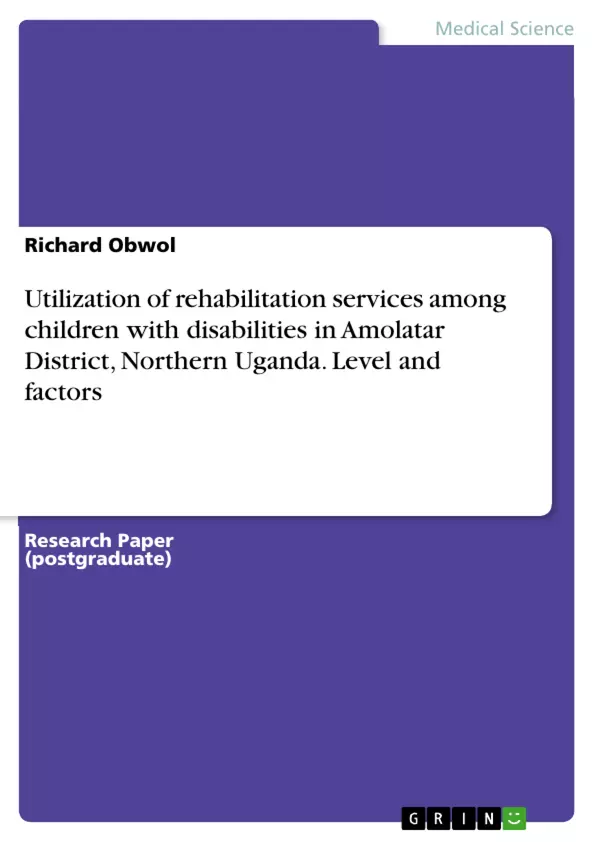The main objective of this study was to determine the prevalence and factors associated with utilization of rehabilitation services among children with disabilities in the Amolatar District in Northern Uganda.
This was a community based cross-sectional descriptive study involving qualitative and quantitative method. The study employed structured questionnaire and KII to collect the data. Data will be analysed using SPSS version 23 and thematic content analysis for quantitative and qualitative data, respectively.
About 110 to 190 million adults encounter substantial difficulties in their daily lives. In order to reduce the number of people with disabilities (PWDs), the WHO Member States in 2014 endorsed global disability action plan 2014–2021 with the aim to remove barriers and improve access to health services; strengthen and extend rehabilitation and community-based rehabilitation.
Inhaltsverzeichnis (Table of Contents)
- ABREVATION AND ACRONYMS
- OPERATIONAL TERMS
- ABSTRACT
- CHAPTER ONE: INTRODUCTION
- 1.1 Background
- 1.2 Statement of the problem
- 1.3 Study Objectives
- 1.3.1 General Objective
- 1.3.2 Specific objectives of the study
- 1.4 Research question
- 1.5 Scope of the study
- 1.6 Justification
- 1.7 Significance of the study
- 1.8 Conceptual framework
- 1.8.1 Narrative
- CHAPTER 2: LITERATURE REVIEW
- 2.0 Introduction
- 2.1 Factors Influencing utilization of rehabilitation services
- 2.1.1 Adherence
- 2.1.2 Travelling Distance to the Clinic
- 2.1.3 Communication between Caregiver and Clinician
- 2.1.4. Parent's Attitude
- 2.1.5. Social/ Economic Support
- 2.1.6 Waiting Time
- 2.1.7 Parent/Caregiver's Knowledge of the condition
- 2.2 Conclusion and gaps
- CHAPTER THREE: METHODOLOGY
- 3.1 Study design
- 3.2 Study site & setting
- 3.3 Study populations
- 3.4 Sampling techniques
- 3.5 Sample size determination
- 3.6 Study procedure
- 3.7 Eligibility criteria (inclusion & exclusion)
- 3.7.1 Inclusion criteria
- 3.7.2 Exclusion criteria
- 3.8 Data management
- 3.8.1 Data collection method and instrument
- 3.8.2 Data entry & cleaning
- 3.8.3 Data analysis
- 3.8.4 Measurement of variables (quantitative studies)
- 3.9 Quality control (validity & reliability)
- 3.10 Ethical considerations
- 3.10.1 Approval
- 3.10.2 Consent
- 3.10.3 Privacy protection and Confidentiality
- 3.10.4 Safety
- 3.11 Study limitations
- CHAPTER FOUR: DATA ANALYSIS AND PRESENTATION
- 4.0 Introduction
- 4.1 Demographic Characteristics of the Participants
- 4.2 Level of utilization of rehabilitation services
- 4.3 Parental factors associated with utilization of rehabilitation services
- 4.4 Facility Related Factors
- CHAPTER 5: DISCUSION
- 5.0 Introduction
- 5.1 Level of utilization of rehabilitation services
- 5.2 Social- demographic factors and utilization of rehabilitation service
- 5.3 Parental factors associated with utilization of rehabilitation services
- 5.4 Facility related factors associated with utilization of rehabilitation services
Zielsetzung und Themenschwerpunkte (Objectives and Key Themes)
This research study examines the level of rehabilitation services utilization among children with disabilities in Amolatar District, Uganda, aiming to identify factors associated with this utilization. The study focuses on understanding the barriers and facilitators to accessing rehabilitation services, which are crucial for improving the quality of life for children with disabilities. The objectives of the study include:
- To determine the level of utilization of rehabilitation services among children with disabilities in Amolatar District.
- To identify parental factors associated with utilization of rehabilitation services.
- To assess the influence of facility related factors on the utilization of rehabilitation services.
- To explore the relationship between social-demographic characteristics and rehabilitation service utilization.
- To provide evidence-based recommendations for improving the accessibility and utilization of rehabilitation services for children with disabilities in Amolatar District.
Zusammenfassung der Kapitel (Chapter Summaries)
The study begins by establishing the background and importance of understanding the utilization of rehabilitation services among children with disabilities. It also outlines the research objectives and questions, as well as the scope and justification of the study. Chapter 2 delves into a comprehensive literature review, exploring various factors that influence the utilization of rehabilitation services. This includes elements like adherence, travelling distance, communication between caregivers and clinicians, parental attitudes, social and economic support, waiting times, and caregiver knowledge. Chapter 3 outlines the methodology employed in the study, which includes a descriptive cross-sectional design. The study population, sampling techniques, data collection methods, and ethical considerations are all detailed. Chapter 4 presents the data analysis and findings, highlighting the demographic characteristics of the participants, the level of rehabilitation service utilization, and the associated parental and facility related factors. Finally, Chapter 5 discusses the findings, drawing connections between the results and the existing literature, and exploring the implications of the study.
Schlüsselwörter (Keywords)
This study focuses on the utilization of rehabilitation services for children with disabilities, exploring key themes such as accessibility, parental factors, facility characteristics, and socio-demographic variables. It aims to provide insights into the barriers and facilitators of rehabilitation service utilization, ultimately contributing to improved interventions for children with disabilities in the Amolatar District.
- Arbeit zitieren
- Richard Obwol (Autor:in), 2023, Utilization of rehabilitation services among children with disabilities in Amolatar District, Northern Uganda. Level and factors, München, GRIN Verlag, https://www.grin.com/document/1319276



